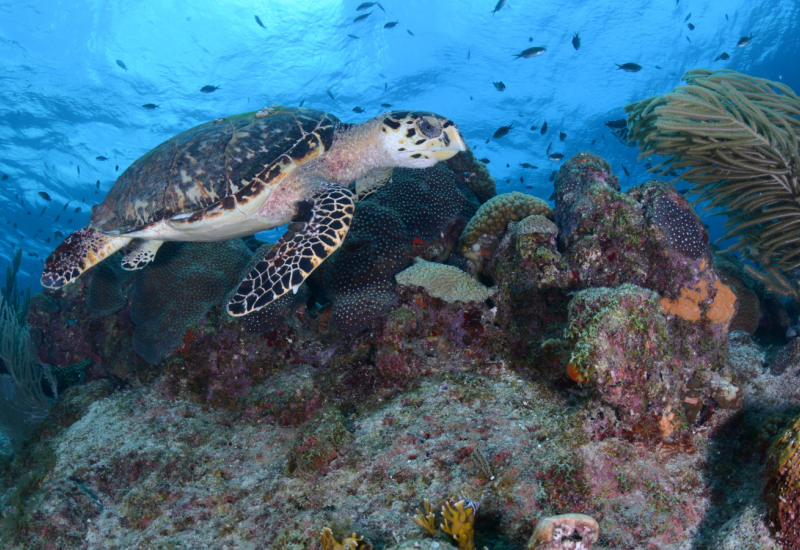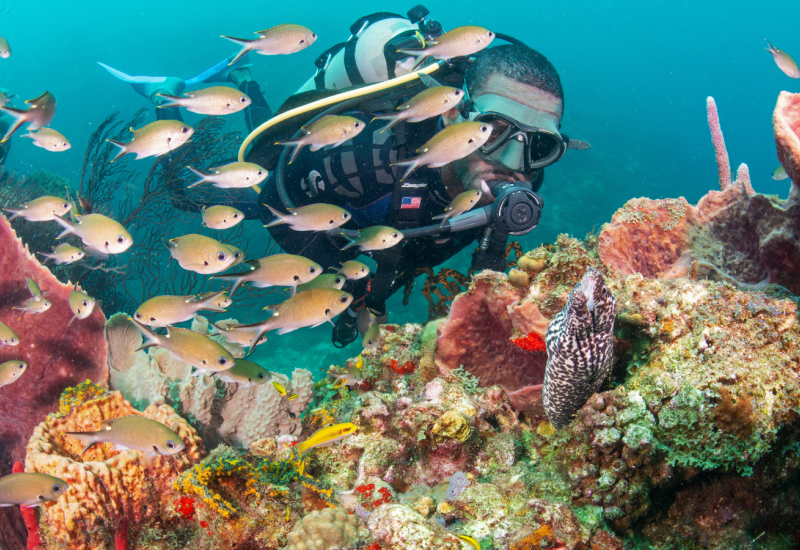The Wild Waters of Saba & Beyond

ShutterstockA town overlooks the steep hills of Saba island.
It doesn't get any better than this. I'm relaxing on powder-soft Maho Beach, where the water's a supernatural shade of turquoise. As I wade in the warm shallows, I begin to think: yep, I could really get used to this.
But then — out of nowhere — a roaring sandstorm surges in my direction. Gale-force winds rip across the narrow strip of beach, driving fine grains of sand into my hair, ears and every pore of my skin. I get blown off my feet and rammed straight into the water. The force is so strong I can't get up. My backpack and flip-flops, which I'd left on the beach, have been whooshed into the water along with everyone else's stuff, and I watch them float away.
Within seconds, the fierce winds abruptly subside. Sunbathers return, we collect our things, and the beach returns to its glorious status quo. As if nothing happened.
Wiiiiild!, I think. But even wilder is this: This exact scenario is repeated at least half a dozen times a day.
Maho, on the south shore of the Dutch Caribbean island of Sint Maarten, has the distinction of lying a few feet from the runway of an international airport. Here, when commercial jets leave Princess Juliana Airport, the prop blast tears across Maho like a sirocco whipping across the Sahara. When they come in for a landing, they often descend to within 100 hair-raising feet of shore. At nearby Sunset Bar & Grill — a lively joint by day or night — an upright surfboard posts the day's arrivals and departures, so thrill-seekers know precisely when to expect the adrenaline rush of being on the underside of an incoming 747 or being tumbled by the blast of an outgoing one.
This high-velocity action is Day One of my weeklong adventure in the Eastern Caribbean. I've come here to begin an excursion aboard the Caribbean Explorer II that involves diving around the islands of Saba, St. Eustatius and St. Kitts. Since Sint Maarten is not on the liveaboard's agenda other than as a jumping-off point, I arrive a day early to see as much as I can — and get an involuntary dermabrasion in the process. It turns out to be the perfect introduction to a week of diving that's so extraordinary it can only be described as ... wiiiild.
Leaving Sint Maarten
The smallest landmass in the world to be shared by two countries, the island is neatly divided in half: French St. Martin to the north and Dutch Sint Maarten to the south. In St. Martin, you'll find a typically Gallic assortment of pleasures: gourmet restaurants, patisseries and a hugely popular nude beach. On the other side, Sint Maarten's capital of Phillipsburg is home to duty-free shopathons, casinos and pleasant strolls along its main drag, Front Street. Besides the ubiquitous Amstels and one little shop selling Delft pottery, there's nothing terribly Dutch about the place. But Phillipsburg has its charms and, best of all, it offers access to the island's premier dive site, Proselyte Reef, named for a British frigate that sank here in 1801, its remains still visible in 50 feet of water.
One day to see this split-personality island is not enough, but I manage to visit a handful of beautiful beaches — not the nude one, alas — before arriving at the Explorer's dock for the captain's pre-trip briefing. After introducing the crew and reviewing our itinerary, the captain goes over the boat's rules, such as: "Get rid of any contraband before we leave, for obvious reasons."
There are nine divers onboard--a cross-section of personalities and professions that include air traffic controller, horticulturist, German teacher and Baghdad-based security guard — none of whom, thankfully, brought contraband. The winds are up when we leave port, at 4 a.m., and are still kicking when we reach our first stop, the island of Saba, three hours later.
Saba
The volcanic island of Saba rises up out of the eastern Caribbean like a faceted jewel ringed by a rocky coastline — no beaches here, nude or otherwise — topped with elfin rainforest. At five square miles, it's a speck of a place, but it's packed with dramatic vistas, swerving switchbacks and swooping contours. If Frank Gehry ever designed an island, it would surely look like Saba.
Divers can explore Saba from a live-aboard, as I do, or base themselves in one of the flower-filled villages that dot the island. A good choice is Windwardside, which looks like it has leapt off the pages of a storybook, complete with cozy cottages and crooked little lanes. It is a creative place, filled with artists, writers and, presumably, the descendants of the pirates who hid out here back in the day (and whose stories of murders and mayhem — the unvarnished Pirates of the Caribbean — are told in a permanent exhibit at Saba's Treasure, a friendly local pub). Spend a few days in Windwardside, or even an hour or two if you're day-tripping, and you'll see why this town exerts such a magical, magnetic pull on visitors, ex-pats and divers alike.
In-the-know divers have tried to keep Saba a secret for years, but word got out, and Saba has become one of the top destinations in the Caribbean. Though it has yet to see anything close to the volume of traffic of Cayman or the Bahamas, the island — wisely and preemptively — created a marine reserve to safeguard its underwater resources. Established in 1987, the Saba Marine Park encircles the island and protects the waters to a depth of 200 feet. The island's moored dive sites range from pristine offshore pinnacles to near-shore coral ridges, all encrusted with corals, sponges and sea fans and populated by hawksbill turtles, stingrays and bright tropicals.
Saba: Standout Dives
Diamond Rock
"This is the premier site on Saba," says divemaster Mike Szekely, pointing to a jagged, guano-flecked pinnacle. The water has been choppy ever since we arrived, and we watch it crash hard against the rock. Diamond Rock consists of three mounds below, but only two break the surface; there's a gash between the pinnacles at 50 feet. "Whatever you do," he warns, "don't swim between them. It's like a dishwasher in there."
We descend to the sandy bottom at 80 feet and swim with the current, counterclockwise around the rock. Gazing up, I am mesmerized by how the intense surface action looks like a sinister cloud of black smoke swirling around the tip of a dark mountain. It's a ravishingly cinematic sight, an underwater Mordor, straight out of Lord of the Rings.
Below, though, it's a different scene, a peaceable kingdom where horse-eye jacks and barracuda slither around serenely, where a baby hawksbill tries to make a meal out of a clump of algae, and an adult turtle, possibly the watchful mom, drifts overhead. Barrel sponges, orange elephant ear sponges, anemones and encrusting corals all vie for position on the decorated faces of the rock. We follow up this dive at Man O' War Shoals, a similarly rocky structure that sits to Diamond Rock's east. It's an equally thrilling dive, the main difference being that Man O' War Shoals is entirely submerged, its peaks rising to within 15 feet of the surface.
Third Encounter and Eye Of The Needle
A mile off Saba's west coast is a site so wildly surreal it's practically mystical. Called Third Encounter, it's a cluster of pinnacles rising from the seafloor to a depth of 90 feet. The mooring is on a plateau that serves as the base of Third Encounter, a worthwhile dive in its own right for the schooling jacks and black-tips that make the rounds here. But the real excitement lies a short distance off, at Eye of the Needle. To reach it, you need to swim away from the mooring, into the blue beyond, temporarily losing any frame of reference. Then, out of the infinite blue, a slender pinnacle emerges, a spindle cloaked with corals and crowned with a huge barrel sponge. At its top — the breathtaking eye of the needle itself — the pinnacle tapers to just a few feet in diameter, with reef sharks and grouper often making lazy circles around it.
Tent Wall and Tent Reef
"I love this dive," says Mike of our next site, Tent Wall, off the southwest corner of Saba. "You can do it again and again because you always see something different." Since he has not steered us wrong yet, we eagerly gear up and giant-stride into the water. We descend to the top of the reef at 50 feet, then continue down to 80 and swim along the intricate and color-saturated wall. Slowly working our way back up, we pass oversized tube sponges, queen angels and rock beauties, while several barracuda patrol in the distance.
Tent Wall's sister site is Tent Reef, and doing these two dives together makes a great one-two punch. Tent Reef is a popular shallow dive because the reef comes to within just 10 feet of the surface. With a maximum depth of 45 feet, you get substantial bottom time here. Red-lipped blennies, jacks and grouper hang out in the undercuts and tunnels that decorate the reef. During our three days at Saba we hit other don't-miss sites — Ladder Labyrinth, Torrens Point and Tedron Reef — and could easily spend the whole week diving Saba alone. But Statia and St. Kitts beckon, so we leave this extraordinary little island and make a late-night crossing to our next stop.
Hike Mt. Scenery
The highest peak in the kingdom of the Netherlands happens to be right here, on Saba, topped with lush cloud forest. Start your journey in Windwardside, where a trail sign informs you that you've got 1,064 steps to reach the peak (estimated hiking time: 90 minutes). For more info on hiking on Saba, visit Saba Tourism.
Learn a Thing or Two If you are diving Saba in the month of October, don't miss Sea and Learn, an acclaimed series of events, field projects and presentations on the natural environment, featuring expert ecologists and marine biologists. The free programs take place in Windwardside and various locations around the island. Visit the Sea and Learn website for more info.
St. Eustatius
We are greeted on Statia — as everyone calls this 12-square-mile island — by a soft-spoken marine ranger named Nadio. Nadio works with the Statia National Marine Park, overseeing the island's moored dive sites, most of which are clustered off the southwestern coast. After giving each of us a marine park tag, which we clip to our BCs to show we've ponied up the $6-per-dive (or $30 annual) park fee, he jumps in the water with us. "My job is to observe stuff, so nothing gets damaged," he explains good-naturedly. "I am not here to slap your hands."
Like Saba, Statia has recognized the immense value of its underwater resources and is committed to protecting the coral reefs, ledges and offshore pinnacles that comprise the underwater seascape. Tourism is still nascent here, depths are shallow at many top sites, and marine life is plentiful. Chances are, yours will be the only dive boat at any given site.
St. Eustatius: Standout Dives
Barracuda Reef
The conditions have dramatically improved overnight, with calm water and vis in the 70-foot range. We start out at Barracuda Reef, a misnomer because, as Mike explains during the briefing, "there are, like, no barracuda here." But there is plenty of action to keep us entertained at 50 to 70 feet, where we swim along a series of pristine ledges dotted with lobster-filled nooks. I keep a close eye on Nadio, certain that he knows where the good stuff is. Sure enough, he's the first to sight the banded coral shrimp, the spotted drum and the hawksbill tucked between a pair of rocks.
Double Wreck
At Double Wreck, the remains of two 18th-century wooden ships have formed a rich reef system at 60 feet. Dozens of southern stingrays have laid claim to the flats around the wreckage, as well as the sandy expanse at neighboring Stingray Wreck. Camouflaged in the sand, the rays are invisible except for the heartbeat motion of their dark, eye-like spiracles. Double Wreck is just one (or two, to be precise) of an estimated 200 shipwrecks off Statia. Most are not divable, but they reflect the island's role in 18th-century maritime history, when little Statia was one of the busiest ports in the world.
St. Kitts
Dive sites around the paddle-shaped island of St. Kitts range from near-shore reefs to the gorgeous River Taw, one of the most photogenic wrecks in the Caribbean. St. Kitts has never hit the diving radar in a big way, but it does offer special attractions both underwater and above. For one, the island is a major nesting ground for giant leatherbacks, which can be sighted between March and May. And at higher elevations, notably in the forests around the dormant volcano, Mt. Liamuiga, you can see a huge population of African green vervet monkeys. But divers will have plenty to keep them engaged underwater; in addition to the sites below, don't miss St. Kitts' sister island, Nevis, which offers a wealth of diving off its western shore and in the channel between the two islands.
St. Kitts: Standout Dives
River Taw
The River Taw, a 144-foot freighter that sank in 1985 and was split by a hurricane four years later, is St. Kitts' must-dive site. The ship's two beautifully encrusted sections lie about 40 feet apart at a depth of 50 feet, making this an excellent and relatively shallow dive. There is easy penetration of this soft coral- and hydroid-cloaked wreck and plenty to explore, including a ladder with an artful arrangement of conch shells on it. Not far from the site are the remains of a minivan and a bulldozer.
Paradise Reef This site off the northwest corner of St. Kitts consists of undulating coral canyon formations interwoven with sand gullies. The action is in the 45- to 70-foot range, where you'll see flying gurnards, spotted morays, blue tang and goatfish. In the sandy areas surrounding the reef system are heavily encrusted anchors and an upright car that was swept offshore by a hurricane.
InDepth
Water Conditions: Water temperatures range from 77 to 90 degrees, depending on the time of year. Expect visibility to reach 100 to 150 feet in winter and 60 to 100 feet in summer.
Climate: Daytime temperatures range between 70 and 90 degrees.
Money Matters: The official currency of Saba, Statia and Sint Maarten is the Netherlands Antilles guilder (NAFl$1.77 = US$1 fixed). The official currency of St. Kitts is the Eastern Caribbean dollar (EC$2.68 = US$1 fixed).
Language: The official language on Saba and Sint Maarten is Dutch, but English is widely spoken. On Statia, English is the official language, but Papiamento, French and Spanish are also spoken. English is the official language on St. Kitts.
Documents: A valid passport and return or ongoing ticket are required. The departure tax is usually included in the price of your airline ticket.
Tourism: Saba Tourist Bureau; St. Eustatius Tourism Development Foundation; St. Kitts Tourism Authority; St. Maarten Tourism Bureau.










